check engine light SKODA FABIA 2006 2.G / 5J Owner's Manual
[x] Cancel search | Manufacturer: SKODA, Model Year: 2006, Model line: FABIA, Model: SKODA FABIA 2006 2.G / 5JPages: 258, PDF Size: 44.86 MB
Page 6 of 258
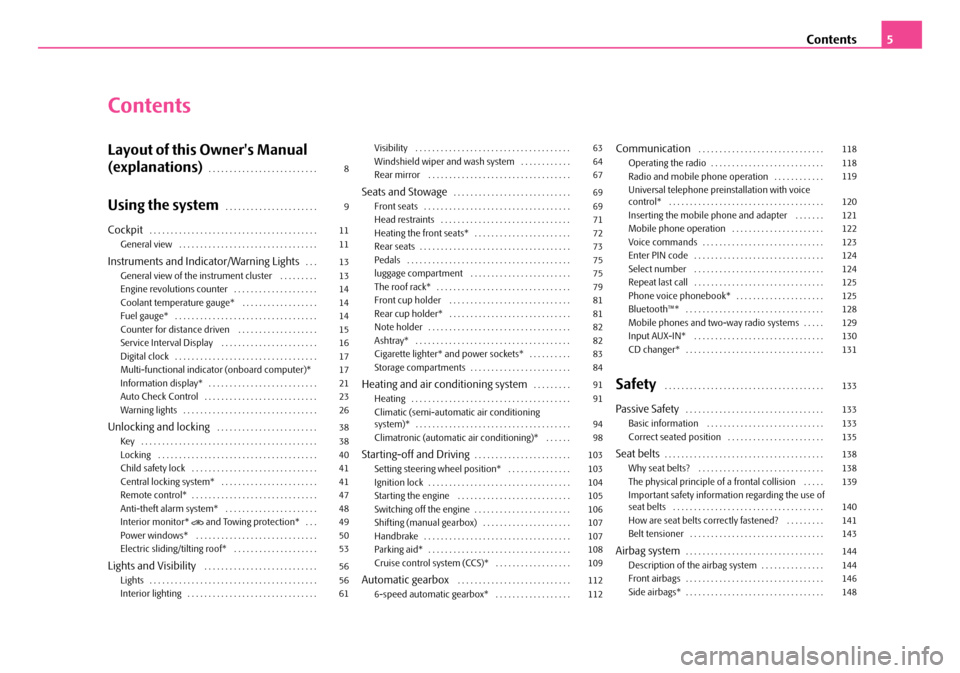
Contents5
Contents
Layout of this Owner's Manual
(explanations). . . . . . . . . . . . . . . . . . . . . . . . . .
Using the system. . . . . . . . . . . . . . . . . . . . . .
Cockpit. . . . . . . . . . . . . . . . . . . . . . . . . . . . . . . . . . . . . . . . General view . . . . . . . . . . . . . . . . . . . . . . . . . . . . . . . . .
Instruments and Indicator/Warning Lights. . . General view of the instrument cluster . . . . . . . . . Engine revolutions counter . . . . . . . . . . . . . . . . . . . . Coolant temperature gauge* . . . . . . . . . . . . . . . . . . Fuel gauge* . . . . . . . . . . . . . . . . . . . . . . . . . . . . . . . . . . Counter for distance driven . . . . . . . . . . . . . . . . . . . Service Interval Display . . . . . . . . . . . . . . . . . . . . . . . Digital clock . . . . . . . . . . . . . . . . . . . . . . . . . . . . . . . . . . Multi-functional indicato r (onboard computer)* Information display* . . . . . . . . . . . . . . . . . . . . . . . . . . Auto Check Control . . . . . . . . . . . . . . . . . . . . . . . . . . . Warning lights . . . . . . . . . . . . . . . . . . . . . . . . . . . . . . . .
Unlocking and locking . . . . . . . . . . . . . . . . . . . . . . . . Key . . . . . . . . . . . . . . . . . . . . . . . . . . . . . . . . . . . . . . . . . . Locking . . . . . . . . . . . . . . . . . . . . . . . . . . . . . . . . . . . . . . Child safety lock . . . . . . . . . . . . . . . . . . . . . . . . . . . . . . Central locking system* . . . . . . . . . . . . . . . . . . . . . . . Remote control* . . . . . . . . . . . . . . . . . . . . . . . . . . . . . . Anti-theft alarm system* . . . . . . . . . . . . . . . . . . . . . . Interior monitor* and Towing protection* . . . Power windows* . . . . . . . . . . . . . . . . . . . . . . . . . . . . . Electric sliding/tilting roof* . . . . . . . . . . . . . . . . . . . .
Lights and Visibility . . . . . . . . . . . . . . . . . . . . . . . . . . . Lights . . . . . . . . . . . . . . . . . . . . . . . . . . . . . . . . . . . . . . . . Interior lighting . . . . . . . . . . . . . . . . . . . . . . . . . . . . . . .
Visibility . . . . . . . . . . . . . . . . . . . . . . . . . . . . . . . . . . . . . Windshield wiper and wash system . . . . . . . . . . . . Rear mirror . . . . . . . . . . . . . . . . . . . . . . . . . . . . . . . . . .
Seats and Stowage. . . . . . . . . . . . . . . . . . . . . . . . . . . . Front seats . . . . . . . . . . . . . . . . . . . . . . . . . . . . . . . . . . . Head restraints . . . . . . . . . . . . . . . . . . . . . . . . . . . . . . . Heating the front seats* . . . . . . . . . . . . . . . . . . . . . . . Rear seats . . . . . . . . . . . . . . . . . . . . . . . . . . . . . . . . . . . . Pedals . . . . . . . . . . . . . . . . . . . . . . . . . . . . . . . . . . . . . . . luggage compartment . . . . . . . . . . . . . . . . . . . . . . . . The roof rack* . . . . . . . . . . . . . . . . . . . . . . . . . . . . . . . . Front cup holder . . . . . . . . . . . . . . . . . . . . . . . . . . . . . Rear cup holder* . . . . . . . . . . . . . . . . . . . . . . . . . . . . . Note holder . . . . . . . . . . . . . . . . . . . . . . . . . . . . . . . . . . Ashtray* . . . . . . . . . . . . . . . . . . . . . . . . . . . . . . . . . . . . . Cigarette lighter* and power sockets* . . . . . . . . . . Storage compartments . . . . . . . . . . . . . . . . . . . . . . . .
Heating and air conditioning system. . . . . . . . . Heating . . . . . . . . . . . . . . . . . . . . . . . . . . . . . . . . . . . . . . Climatic (semi-automatic air conditioning system)* . . . . . . . . . . . . . . . . . . . . . . . . . . . . . . . . . . . . . Climatronic (automatic air conditioning)* . . . . . .
Starting-off and Driving. . . . . . . . . . . . . . . . . . . . . . . Setting steering wheel position* . . . . . . . . . . . . . . . Ignition lock . . . . . . . . . . . . . . . . . . . . . . . . . . . . . . . . . . Starting the engine . . . . . . . . . . . . . . . . . . . . . . . . . . . Switching off the engine . . . . . . . . . . . . . . . . . . . . . . . Shifting (manual gearbox) . . . . . . . . . . . . . . . . . . . . . Handbrake . . . . . . . . . . . . . . . . . . . . . . . . . . . . . . . . . . . Parking aid* . . . . . . . . . . . . . . . . . . . . . . . . . . . . . . . . . . Cruise control system (CCS)* . . . . . . . . . . . . . . . . . .
Automatic gearbox . . . . . . . . . . . . . . . . . . . . . . . . . . . 6-speed automatic gearbox* . . . . . . . . . . . . . . . . . .
Communication . . . . . . . . . . . . . . . . . . . . . . . . . . . . . . Operating the radio . . . . . . . . . . . . . . . . . . . . . . . . . . . Radio and mobile phone operation . . . . . . . . . . . . Universal telephone preinstallation with voice control* . . . . . . . . . . . . . . . . . . . . . . . . . . . . . . . . . . . . . Inserting the mobile phone and adapter . . . . . . . Mobile phone operation . . . . . . . . . . . . . . . . . . . . . . Voice commands . . . . . . . . . . . . . . . . . . . . . . . . . . . . . Enter PIN code . . . . . . . . . . . . . . . . . . . . . . . . . . . . . . . Select number . . . . . . . . . . . . . . . . . . . . . . . . . . . . . . . Repeat last call . . . . . . . . . . . . . . . . . . . . . . . . . . . . . . . Phone voice phonebook* . . . . . . . . . . . . . . . . . . . . . Bluetooth™* . . . . . . . . . . . . . . . . . . . . . . . . . . . . . . . . . Mobile phones and two-way radio systems . . . . . Input AUX-IN* . . . . . . . . . . . . . . . . . . . . . . . . . . . . . . . CD changer* . . . . . . . . . . . . . . . . . . . . . . . . . . . . . . . . .
Safety . . . . . . . . . . . . . . . . . . . . . . . . . . . . . . . . . . . . . .
Passive Safety . . . . . . . . . . . . . . . . . . . . . . . . . . . . . . . . . Basic information . . . . . . . . . . . . . . . . . . . . . . . . . . . . Correct seated position . . . . . . . . . . . . . . . . . . . . . . .
Seat belts. . . . . . . . . . . . . . . . . . . . . . . . . . . . . . . . . . . . . . Why seat belts? . . . . . . . . . . . . . . . . . . . . . . . . . . . . . . The physical principle of a frontal collision . . . . . Important safety information regarding the use of seat belts . . . . . . . . . . . . . . . . . . . . . . . . . . . . . . . . . . . . How are seat belts correctly fastened? . . . . . . . . . Belt tensioner . . . . . . . . . . . . . . . . . . . . . . . . . . . . . . . .
Airbag system. . . . . . . . . . . . . . . . . . . . . . . . . . . . . . . . . Description of the airbag system . . . . . . . . . . . . . . . Front airbags . . . . . . . . . . . . . . . . . . . . . . . . . . . . . . . . . Side airbags* . . . . . . . . . . . . . . . . . . . . . . . . . . . . . . . . .
8
9
11 11
13 13 14141415161717212326
38 38 4041414748495053
56 56 61
63 6467
69 69 717273757579818182828384
91 91
94 98
103 103 104105106107107108109
112 112
118 118 119
120 121122123124124125125128129130131
133
133 133 135
138 138 139
140 141143
144 144 146148
NKO A05Fabia 20.book Page 5 Tuesday, September 26, 2006 8:38 AM
Page 26 of 258
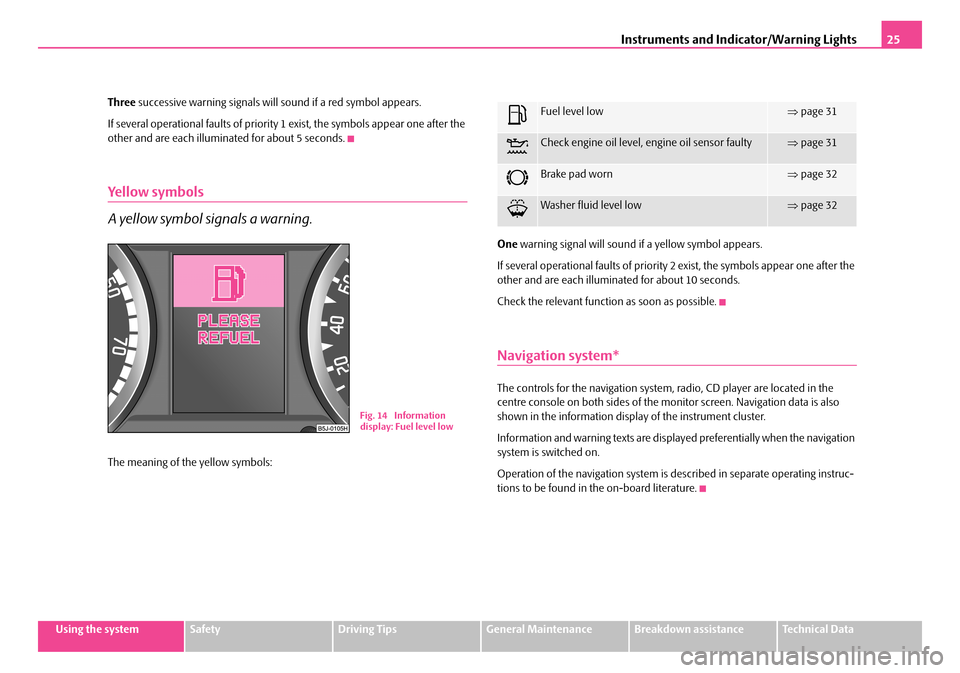
Instruments and Indicator/Warning Lights25
Using the systemSafetyDriving TipsGeneral MaintenanceBreakdown assistanceTechnical Data
Three successive warning signals will sound if a red symbol appears.
If several operational faults of priority 1 exist, the symbols appear one after the other and are each illumi nated for about 5 seconds.
Ye l l o w s y m b o l s
A yellow symbol signals a warning.
The meaning of the yellow symbols:
One warning signal will sound if a yellow symbol appears.
If several operational faults of priority 2 exist, the symbols appear one after the other and are each illuminated for about 10 seconds.
Check the relevant function as soon as possible.
Navigation system*
The controls for the navigation system, radio, CD player are located in the centre console on both sides of the mo nitor screen. Navigation data is also shown in the information display of the instrument cluster.
Information and warning texts are displaye d preferentially when the navigation system is switched on.
Operation of the navigation system is described in separate operating instruc- tions to be found in the on-board literature.
Fig. 14 Information display: Fuel level low
Fuel level low⇒ page 31
Check engine oil level, engine oil sensor faulty⇒page 31
Brake pad worn⇒page 32
Washer fluid level low⇒page 32
NKO A05Fabia 20.book Page 25 Tuesday, September 26, 2006 8:38 AM
Page 31 of 258
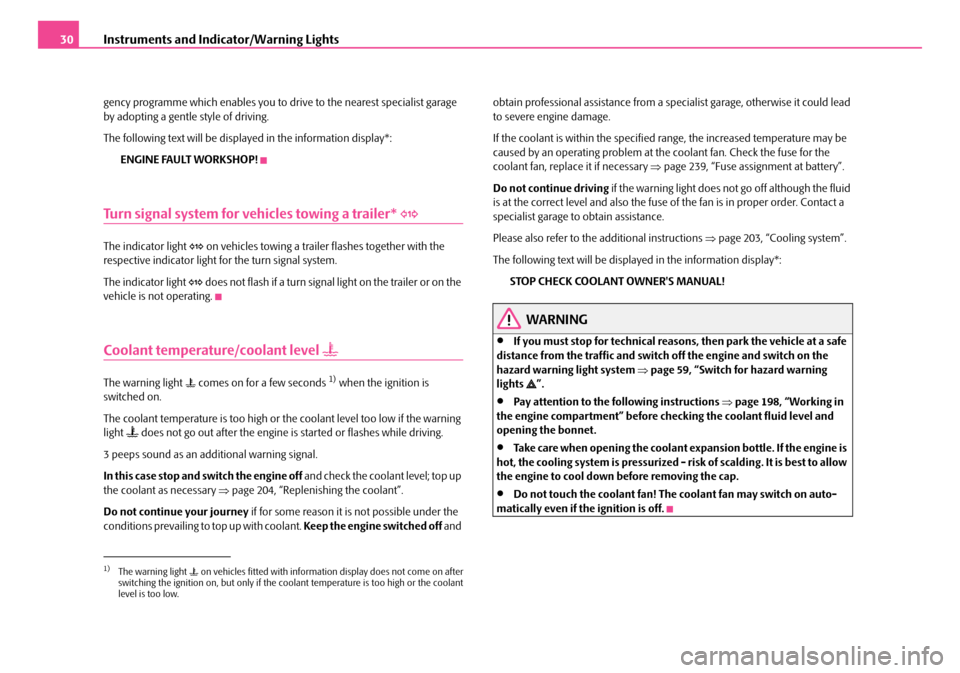
Instruments and Indicator/Warning Lights30
gency programme which enables you to drive to the nearest specialist garage by adopting a gentle style of driving.
The following text will be displayed in the information display*:
ENGINE FAULT WORKSHOP!
Turn signal system for ve hicles towing a trailer*
The indicator light on vehicles towing a trailer flashes together with the respective indicator light for the turn signal system.
The indicator light does not flash if a turn signal light on the trailer or on the vehicle is not operating.
Coolant temperature/coolant level
The warning light comes on for a few seconds 1) when the ignition is switched on.
The coolant temperature is too high or the coolant level too low if the warning light does not go out after the engine is started or flashes while driving.
3 peeps sound as an additional warning signal.
In this case stop and switch the engine off and check the coolant level; top up the coolant as necessary ⇒page 204, “Replenishing the coolant”.
Do not continue your journey if for some reason it is not possible under the conditions prevailing to top up with coolant. Keep the engine switched off and
obtain professional assistance from a specialist garage, otherwise it could lead to severe engine damage.
If the coolant is within the specified range, the increased temperature may be caused by an operating problem at the coolant fan. Check the fuse for the coolant fan, replace it if necessary ⇒page 239, “Fuse assignment at battery”.
Do not continue driving if the warning light does not go off although the fluid is at the correct level and also the fuse of the fan is in proper order. Contact a specialist garage to obtain assistance.
Please also refer to the additional instructions ⇒page 203, “Cooling system”.
The following text will be displayed in the information display*:
STOP CHECK COOLANT OWNER'S MANUAL!
WARNING
•If you must stop for technical reasons, then park the vehicle at a safe distance from the traffic and switch off the engine and switch on the hazard warning light system ⇒page 59, “Switch for hazard warning lights ”.
•Pay attention to the following instructions ⇒page 198, “Working in the engine compartment” before ch ecking the coolant fluid level and opening the bonnet.
•Take care when opening the coolant expansion bottle. If the engine is hot, the cooling system is pressurized - risk of scalding. It is best to allow the engine to cool down before removing the cap.
•Do not touch the coolant fan! The coolant fan may switch on auto- matically even if the ignition is off.
1)The warning light on vehicles fitted with information display does not come on after switching the ignition on, but only if the cool ant temperature is too high or the coolant level is too low.
NKO A05Fabia 20.book Page 30 Tuesday, September 26, 2006 8:38 AM
Page 32 of 258
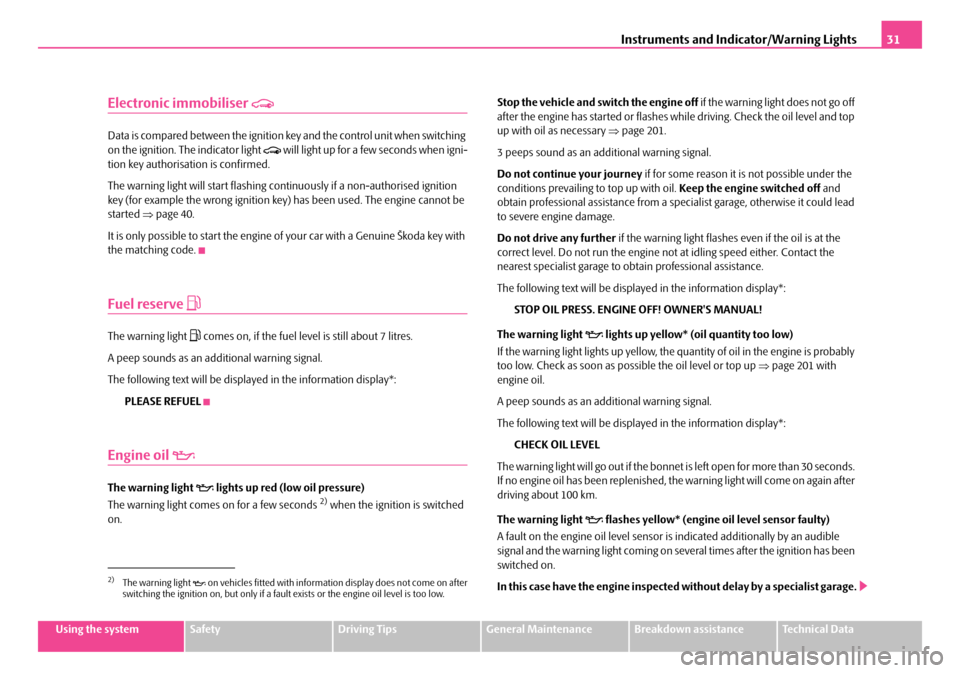
Instruments and Indicator/Warning Lights31
Using the systemSafetyDriving TipsGeneral MaintenanceBreakdown assistanceTechnical Data
Electronic immobiliser
Data is compared between the ignition key and the control unit when switching on the ignition. The indicator light will light up for a few seconds when igni- tion key authorisation is confirmed.
The warning light will start flashing cont inuously if a non-authorised ignition key (for example the wrong ignition key) has been used. The engine cannot be started ⇒page 40.
It is only possible to start the engine of your car with a Genuine Škoda key with the matching code.
Fuel reserve
The warning light comes on, if the fuel level is still about 7 litres.
A peep sounds as an additional warning signal.
The following text will be displayed in the information display*:
PLEASE REFUEL
Engine oil
The warning light lights up red (low oil pressure)
The warning light comes on for a few seconds 2) when the ignition is switched on.
Stop the vehicle and switch the engine off if the warning light does not go off after the engine has started or flashes while driving. Check the oil level and top up with oil as necessary ⇒page 201.
3 peeps sound as an additional warning signal.
Do not continue your journey if for some reason it is not possible under the conditions prevailing to top up with oil. Keep the engine switched off and obtain professional assistance from a specialist garage, otherwise it could lead to severe engine damage.
Do not drive any further if the warning light flashes even if the oil is at the correct level. Do not run the engine no t at idling speed either. Contact the nearest specialist garage to obtain professional assistance.
The following text will be displayed in the information display*:
STOP OIL PRESS. ENGINE OFF! OWNER'S MANUAL!
The warning light lights up yellow* (oil quantity too low)
If the warning light lights up yellow, the qu antity of oil in the engine is probably too low. Check as soon as pos sible the oil level or top up ⇒page 201 with engine oil.
A peep sounds as an additional warning signal.
The following text will be displayed in the information display*:
CHECK OIL LEVEL
The warning light will go out if the bonnet is left open for more than 30 seconds. If no engine oil has been replenished, th e warning light will come on again after driving about 100 km.
The warning light flashes yellow* (engine oil level sensor faulty)
A fault on the engine oil level sensor is indicated additionally by an audible signal and the warning light coming on se veral times after the ignition has been switched on.
In this case have the engine inspecte d without delay by a specialist garage.2)The warning light on vehicles fitted with information display does not come on after switching the ignition on, but only if a fault exists or the engine oil level is too low.
NKO A05Fabia 20.book Page 31 Tuesday, September 26, 2006 8:38 AM
Page 33 of 258
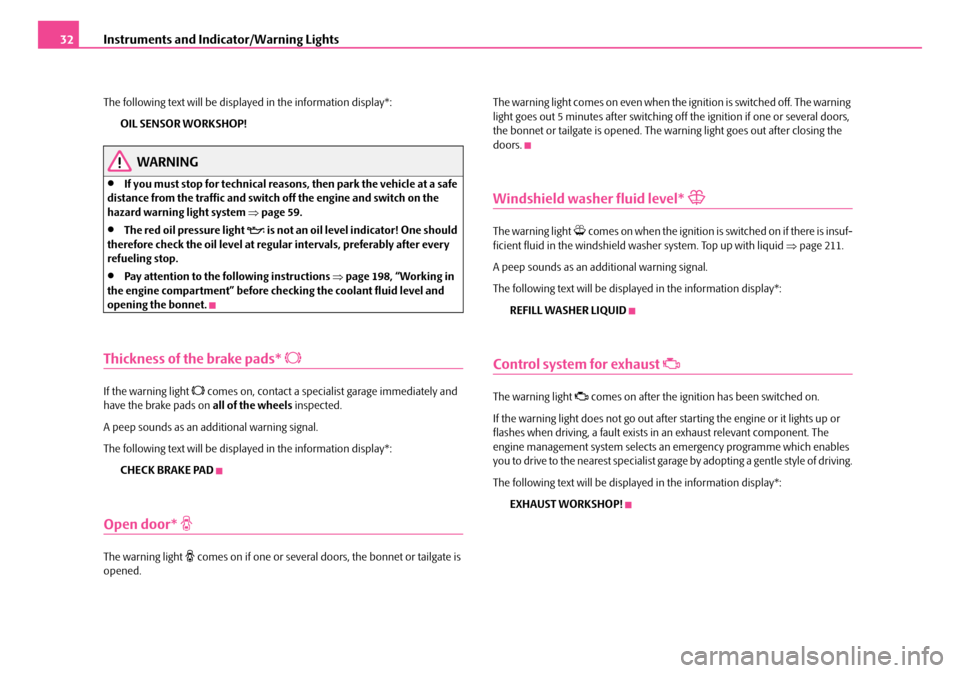
Instruments and Indicator/Warning Lights32
The following text will be displayed in the information display*:
OIL SENSOR WORKSHOP!
WARNING
•If you must stop for technical reasons, then park the vehicle at a safe distance from the traffic and switch off the engine and switch on the hazard warning light system ⇒page 59.
•The red oil pressure light is not an oil level indicator! One should therefore check the oil level at regular intervals, preferably after every refueling stop.
•Pay attention to the following instructions ⇒page 198, “Working in the engine compartment” before checking the coolant fluid level and opening the bonnet.
Thickness of the brake pads*
If the warning light comes on, contact a specialist garage immediately and have the brake pads on all of the wheels inspected.
A peep sounds as an additional warning signal.
The following text will be displayed in the information display*:
CHECK BRAKE PAD
Open door*
The warning light comes on if one or several doors, the bonnet or tailgate is opened.
The warning light comes on even when the ignition is switched off. The warning light goes out 5 minutes after switching off the ignition if one or several doors, the bonnet or tailgate is opened. The warning light goes out after closing the doors.
Windshield washer fluid level*
The warning light comes on when the ignition is switched on if there is insuf-ficient fluid in the windshield washer system. Top up with liquid ⇒page 211.
A peep sounds as an additional warning signal.
The following text will be displayed in the information display*:
REFILL WASHER LIQUID
Control system for exhaust
The warning light comes on after the ignition has been switched on.
If the warning light does not go out after starting the engine or it lights up or flashes when driving, a fault exists in an exhaust relevant component. The engine management system selects an emergency programme which enables you to drive to the nearest specialist gara ge by adopting a gentle style of driving.
The following text will be displayed in the information display*:
EXHAUST WORKSHOP!
NKO A05Fabia 20.book Page 32 Tuesday, September 26, 2006 8:38 AM
Page 34 of 258
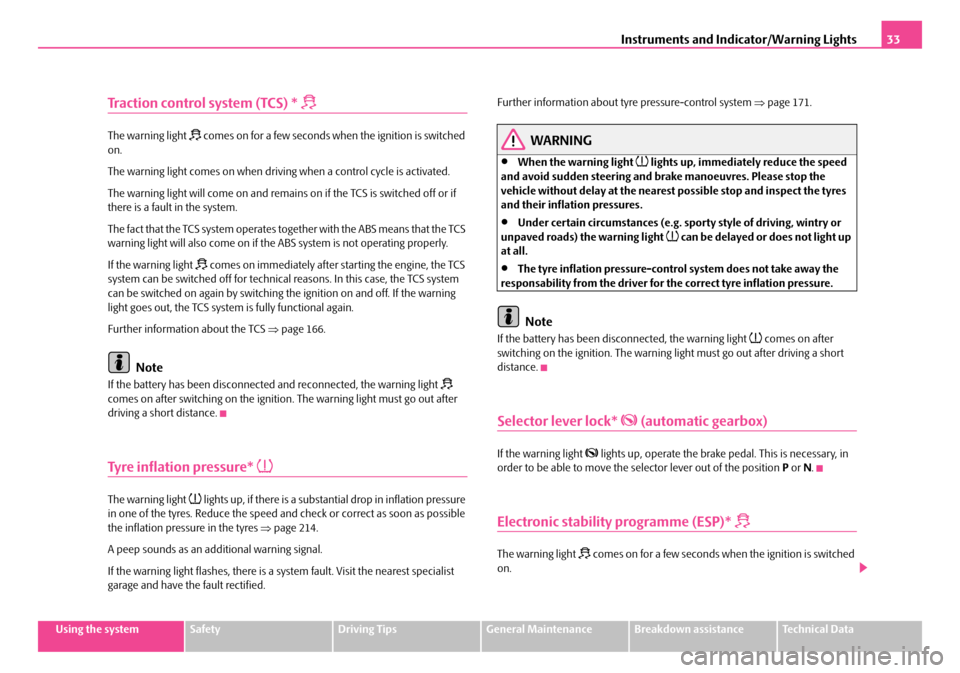
Instruments and Indicator/Warning Lights33
Using the systemSafetyDriving TipsGeneral MaintenanceBreakdown assistanceTechnical Data
Tr a c t i o n c o n t r o l system (TCS) *
The warning light comes on for a few seconds when the ignition is switched on.
The warning light comes on when drivin g when a control cycle is activated.
The warning light will come on and remains on if the TCS is switched off or if there is a fault in the system.
The fact that the TCS system operates together with the ABS means that the TCS warning light will also come on if the ABS system is not operating properly.
If the warning light comes on immediately after starting the engine, the TCS system can be switched off for technica l reasons. In this case, the TCS system can be switched on again by switching th e ignition on and off. If the warning light goes out, the TCS system is fully functional again.
Further information about the TCS ⇒page 166.
Note
If the battery has been disconnected and reconnected, the warning light comes on after switching on the ignition . The warning light must go out after driving a short distance.
Tyre inflation pressure*
The warning light lights up, if there is a substantial drop in inflation pressure in one of the tyres. Reduce the speed and check or correct as soon as possible the inflation pressure in the tyres ⇒page 214.
A peep sounds as an additional warning signal.
If the warning light flashes, there is a system fault. Visit the nearest specialist garage and have the fault rectified.
Further information about tyre pressure-control system ⇒page 171.
WARNING
•When the warning light lights up, immediately reduce the speed and avoid sudden steering and brak e manoeuvres. Please stop the vehicle without delay at the nearest possible stop and inspect the tyres and their inflation pressures.
•Under certain circumstances (e.g. sporty style of driving, wintry or unpaved roads) the warning light can be delayed or does not light up at all.
•The tyre inflation pressure-control system does not take away the responsability from the driver for the correct tyre inflation pressure.
Note
If the battery has been disconnected, the warning light comes on after switching on the ignition. The warning light must go out after driving a short distance.
Selector lever lock* (automatic gearbox)
If the warning light lights up, operate the brake pedal. This is necessary, in order to be able to move the selector lever out of the position P or N.
Electronic stability programme (ESP)*
The warning light comes on for a few seconds when the ignition is switched on.
NKO A05Fabia 20.book Page 33 Tuesday, September 26, 2006 8:38 AM
Page 35 of 258
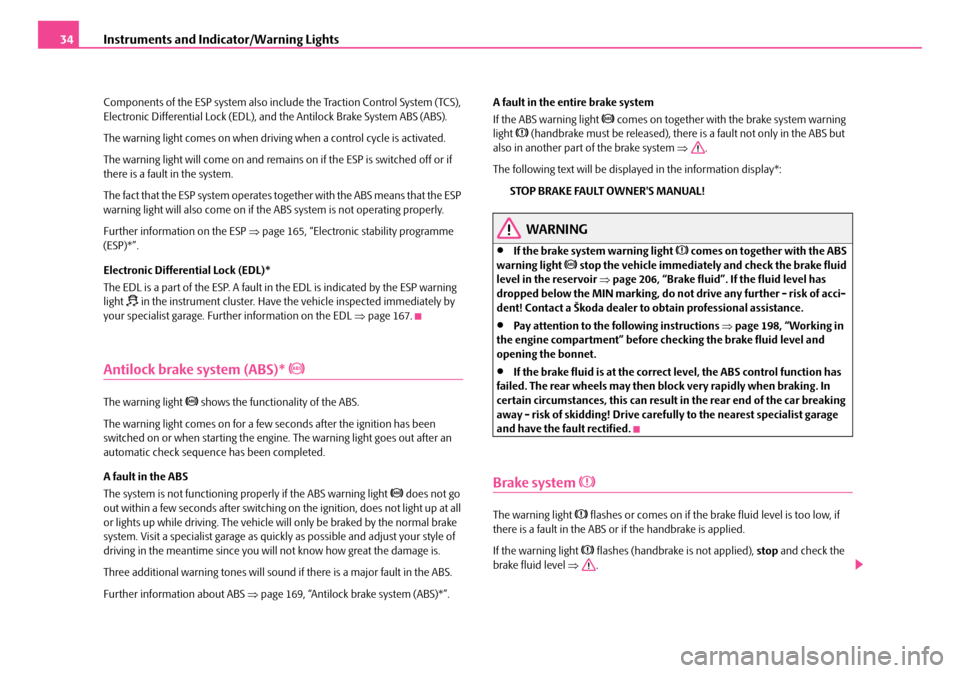
Instruments and Indicator/Warning Lights34
Components of the ESP system also include the Traction Control System (TCS), Electronic Differential Lock (EDL), and the Antilock Brake System ABS (ABS).
The warning light comes on when drivin g when a control cycle is activated.
The warning light will come on and remains on if the ESP is switched off or if there is a fault in the system.
The fact that the ESP system operates together with the ABS means that the ESP warning light will also come on if the ABS system is not operating properly.
Further information on the ESP ⇒page 165, “Electronic stability programme (ESP)*”.
Electronic Differential Lock (EDL)*
The EDL is a part of the ESP. A fault in the EDL is indicated by the ESP warning light in the instrument cluster. Have the vehicle inspected immediately by your specialist garage. Further information on the EDL ⇒page 167.
Antilock brake system (ABS)*
The warning light shows the functionality of the ABS.
The warning light comes on for a few seconds after the ignition has been switched on or when starting the engine. The warning light goes out after an automatic check sequence has been completed.
A fault in the ABS
The system is not functioning properly if the ABS warning light does not go out within a few seconds after switching on the ignition, does not light up at all or lights up while driving. The vehicle wi ll only be braked by the normal brake system. Visit a specialist garage as quickly as possible and adjust your style of driving in the meantime since you will not know how great the damage is.
Three additional warning tones will sound if there is a major fault in the ABS.
Further information about ABS ⇒page 169, “Antilock brake system (ABS)*”.
A fault in the entire brake system
If the ABS warning light comes on together with the brake system warning light (handbrake must be released), ther e is a fault not only in the ABS but also in another part of the brake system ⇒.
The following text will be displayed in the information display*:
STOP BRAKE FAULT OWNER'S MANUAL!
WARNING
•If the brake system warning light comes on together with the ABS warning light stop the vehicle immediatel y and check the brake fluid level in the reservoir ⇒page 206, “Brake fluid”. If the fluid level has dropped below the MIN marking, do not drive any further - risk of acci- dent! Contact a Škoda dealer to obtain professional assistance.
•Pay attention to the following instructions ⇒page 198, “Working in the engine compartment” before checking the brake fluid level and opening the bonnet.
•If the brake fluid is at the correct level, the ABS control function has failed. The rear wheels may then bloc k very rapidly when braking. In certain circumstances, this can result in the rear end of the car breaking away - risk of skidding! Drive carefu lly to the nearest specialist garage and have the fault rectified.
Brake system
The warning light flashes or comes on if the brake fluid level is too low, if there is a fault in the ABS or if the handbrake is applied.
If the warning light flashes (handbrake is not applied), stop and check the brake fluid level ⇒.
NKO A05Fabia 20.book Page 34 Tuesday, September 26, 2006 8:38 AM
Page 36 of 258
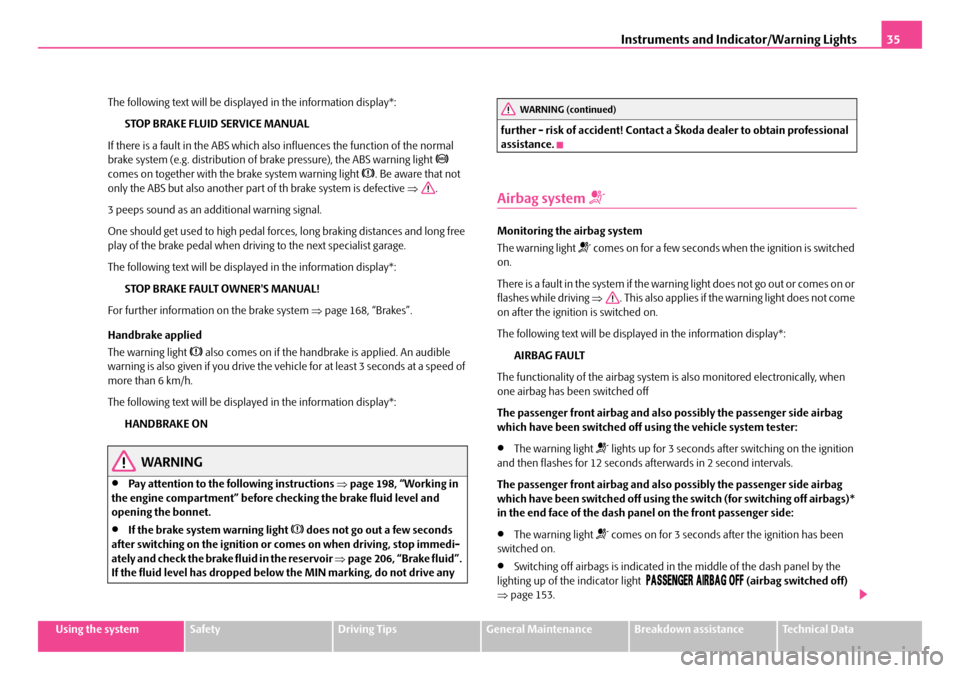
Instruments and Indicator/Warning Lights35
Using the systemSafetyDriving TipsGeneral MaintenanceBreakdown assistanceTechnical Data
The following text will be displayed in the information display*:
STOP BRAKE FLUID SERVICE MANUAL
If there is a fault in the ABS which also influences the function of the normal brake system (e.g. distribution of br ake pressure), the ABS warning light comes on together with the brake system warning light . Be aware that not only the ABS but also another part of th brake system is defective ⇒.
3 peeps sound as an additional warning signal.
One should get used to high pedal forces, long braking distances and long free play of the brake pedal when drivin g to the next specialist garage.
The following text will be displayed in the information display*:
STOP BRAKE FAULT OWNER'S MANUAL!
For further information on the brake system ⇒page 168, “Brakes”.
Handbrake applied
The warning light also comes on if the handbrake is applied. An audible warning is also given if you drive the vehicle for at least 3 seconds at a speed of more than 6 km/h.
The following text will be displayed in the information display*:
HANDBRAKE ON
WARNING
•Pay attention to the following instructions ⇒page 198, “Working in the engine compartment” before ch ecking the brake fluid level and opening the bonnet.
•If the brake system warning light does not go out a few seconds after switching on the ignition or comes on when driving, stop immedi- ately and check the brake fluid in the reservoir ⇒page 206, “Brake fluid”. If the fluid level has dropped below the MIN marking, do not drive any
further - risk of accident! Contact a Škoda dealer to obtain professional assistance.
Airbag system
Monitoring the airbag system
The warning light comes on for a few seconds when the ignition is switched on.
There is a fault in the system if the warning light does not go out or comes on or flashes while driving ⇒. This also applies if the warning light does not come on after the ignition is switched on.
The following text will be displayed in the information display*:
AIRBAG FAULT
The functionality of the airbag system is also monitored electronically, when one airbag has been switched off
The passenger front airbag and also possibly the passenger side airbag which have been switched off us ing the vehicle system tester:
•The warning light lights up for 3 seconds after switching on the ignition and then flashes for 12 seconds afterwards in 2 second intervals.
The passenger front airbag and also possibly the passenger side airbag which have been switched off using the switch (for switching off airbags)* in the end face of the dash panel on the front passenger side:
•The warning light comes on for 3 seconds after the ignition has been switched on.
•Switching off airbags is indicated in the middle of the dash panel by the lighting up of the indicator light (airbag switched off) ⇒ page 153.
WARNING (continued)
NKO A05Fabia 20.book Page 35 Tuesday, September 26, 2006 8:38 AM
Page 37 of 258
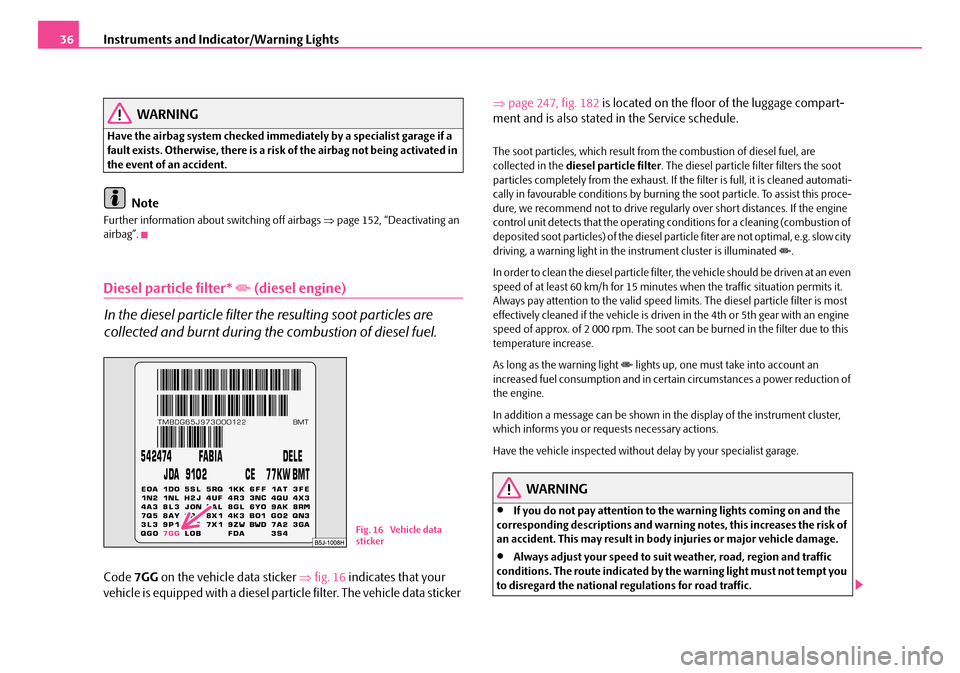
Instruments and Indicator/Warning Lights36
WARNING
Have the airbag system checked immediately by a specialist garage if a fault exists. Otherwise, there is a risk of the airbag not being activated in the event of an accident.
Note
Further information about switching off airbags ⇒page 152, “Deactivating an airbag”.
Diesel particle filter* (diesel engine)
In the diesel particle filter the resulting soot particles are
collected and burnt during the combustion of diesel fuel.
Code 7GG on the vehicle data sticker ⇒fig. 16 indicates that your
vehicle is equipped with a diesel particle filter. The vehicle data sticker
⇒ page 247, fig. 182 is located on the floor of the luggage compart-
ment and is also stated in the Service schedule.
The soot particles, which result from the combustion of diesel fuel, are collected in the diesel particle filter. The diesel particle filter filters the soot particles completely from the exhaust. If th e filter is full, it is cleaned automati- cally in favourable conditions by burning the soot particle. To assist this proce- dure, we recommend not to drive regularl y over short distances. If the engine control unit detects that the operating co nditions for a cleaning (combustion of deposited soot particles) of the diesel particle fiter are not optimal, e.g. slow city driving, a warning light in the instrument cluster is illuminated .
In order to clean the diesel particle filter, the vehicle should be driven at an even speed of at least 60 km/h for 15 minutes when the traffic situation permits it. Always pay attention to the valid speed limi ts. The diesel particle filter is most effectively cleaned if the vehicle is driven in the 4th or 5th gear with an engine speed of approx. of 2 000 rpm. The soot ca n be burned in the filter due to this temperature increase.
As long as the warning light lights up, one must take into account an increased fuel consumption and in certain circumstances a power reduction of the engine.
In addition a message can be shown in th e display of the instrument cluster, which informs you or requests necessary actions.
Have the vehicle inspected without delay by your specialist garage.
WARNING
•If you do not pay attention to the warning lights coming on and the corresponding descriptions and warning notes, this increases the risk of an accident. This may result in bo dy injuries or major vehicle damage.
•Always adjust your speed to suit weather, road, region and traffic conditions. The route indicated by th e warning light must not tempt you to disregard the national regulations for road traffic.
Fig. 16 Vehicle data sticker
NKO A05Fabia 20.book Page 36 Tuesday, September 26, 2006 8:38 AM
Page 99 of 258
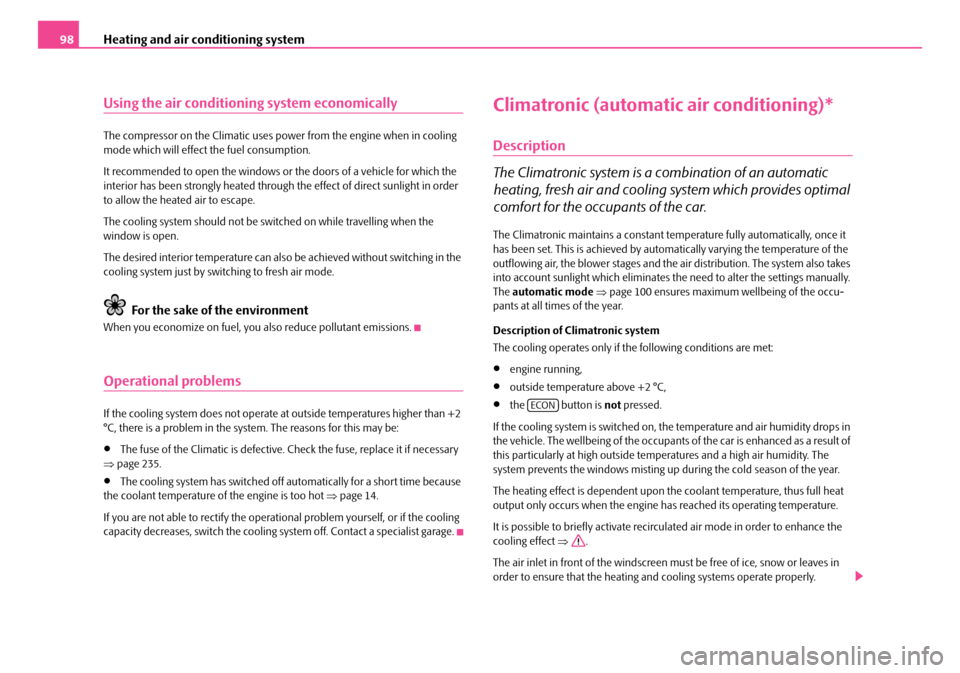
Heating and air conditioning system98
Using the air conditioning system economically
The compressor on the Climatic uses power from the engine when in cooling mode which will effect the fuel consumption.
It recommended to open the windows or the doors of a vehicle for which the interior has been strongly heated through the effect of direct sunlight in order to allow the heated air to escape.
The cooling system should not be switched on while travelling when the window is open.
The desired interior temperature can also be achieved without switching in the cooling system just by switching to fresh air mode.
For the sake of the environment
When you economize on fuel, you also reduce pollutant emissions.
Operational problems
If the cooling system does not operate at outside temperatures higher than +2 °C, there is a problem in the system. The reasons for this may be:
•The fuse of the Climatic is defective. Check the fuse, replace it if necessary ⇒ page 235.
•The cooling system has switched off automatically for a short time because the coolant temperature of the engine is too hot ⇒page 14.
If you are not able to rectify the operat ional problem yourself, or if the cooling capacity decreases, switch the cooling system off. Contact a specialist garage.
Climatronic (automatic air conditioning)*
Description
The Climatronic system is a combination of an automatic
heating, fresh air and cooling system which provides optimal
comfort for the occupants of the car.
The Climatronic maintains a constant temperature fully automatically, once it has been set. This is achieved by auto matically varying the temperature of the outflowing air, the blower stages and the air distribution. The system also takes into account sunlight which eliminates the need to alter the settings manually. The automatic mode ⇒page 100 ensures maximum wellbeing of the occu- pants at all times of the year.
Description of Climatronic system
The cooling operates only if the following conditions are met:
•engine running,
•outside temperature above +2 °C,
•the button is not pressed.
If the cooling system is switched on, the temperature and air humidity drops in the vehicle. The wellbeing of the occupants of the car is enhanced as a result of this particularly at high outside temp eratures and a high air humidity. The system prevents the windows misting up during the cold season of the year.
The heating effect is dependent upon th e coolant temperature, thus full heat output only occurs when the engine has reached its operating temperature.
It is possible to briefly activate recirculated air mode in order to enhance the cooling effect ⇒.
The air inlet in front of the windscreen must be free of ice, snow or leaves in order to ensure that the heating an d cooling systems operate properly.
ECON
NKO A05Fabia 20.book Page 98 Tuesday, September 26, 2006 8:38 AM